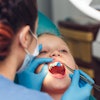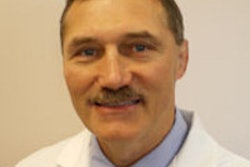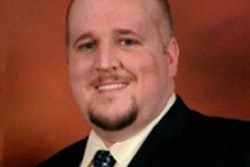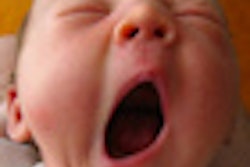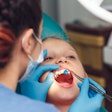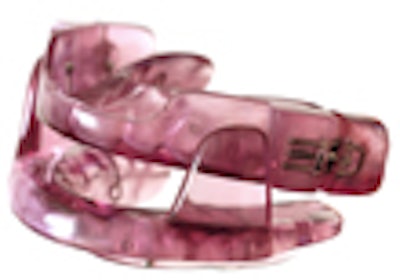
Dentists can do a lot more than give their patients healthy smiles these days. They can also help them get a healthy night’s sleep.
Dentists are becoming leaders in the fight to combat sleep apnea, an under-diagnosed disorder that can lead to high blood pressure, heart disease, and strokes. The American Academy of Sleep Medicine declared in 2006 that oral appliances -- fitted by dentists -- could be used instead of breathing machines to control mild to moderate forms of this debilitating condition.
"Physicians really have a choice," said David B. Rosen, D.M.D., an assistant clinical professor at Tufts University’s dental school, who taught dentists how to treat sleep apnea at the Yankee Dental Congress 33 recently held in Boston. "There’s a lot of good quality research that shows that oral appliances work."
People suffering from sleep apnea stop breathing for at least 10 seconds at a time throughout the night. They may wake up choking or gasping for breath, and are often excessively sleepy during the day. Yet only 5% of sufferers are ever diagnosed with the problem, in which the entire upper airway is blocked.
That’s unfortunate because their disrupted sleep leaves them more prone to morning headaches and reflux. People with sleep apnea have ten times more car accidents than the general public, Dr. Rosen said. They spend more than $5 billion a year on sleep studies, medications, and other therapies.
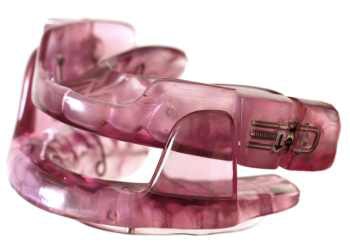 |
| The SomnoMed MAS oral appliance for sleep apnea. Image courtesy of SomnoMed. |
And if left untreated, sleep apnea can shorten adult life spans by as much as half, said Richard B. Drake, D.D.S., a Texas dentist on the board of directors of the American Academy of Dental Sleep Medicine.
Obstructive sleep apnea is surprisingly common, with doctors estimating that 12 million Americans suffer from the life-threatening condition. That’s more Americans than suffer from asthma.
The condition is much more common in men than women and progressively worsens with age and weight gain, Dr. Rosen said. So as the U.S. population gets older and fatter, the number of apnea sufferers is increasing.
The treatment of choice for sleep apnea remains a cumbersome machine that delivers air pressure. Called CPAP (pronounced "see-pap"), short for continuous positive airway pressure machine, the device is difficult to use. Patients have to be hooked up to the noisy machine throughout the night. Even if the racket doesn't keep them awake, they must also get used to wearing a mask all night long -- a tricky maneuver for the typical sleeper who tosses and turns all night long. Because of the hassles, as few as 30% of patients who own a CPAP use it regularly, researchers have found.
Enter the dentist. There are now 54 different kinds of oral appliances that dentists can offer patients, with new models coming out all the time, Dr. Rosen said. Most work by pushing the patients’ jaw forward, which pulls their tongue forward and guarantees that their air passages stay open.
Patients find using them more palatable than the machines, said Dr. Rosen, noting studies show compliance for the oral appliances is as high as 93%.
|
Intraoral examination to fit a Klearway oral appliance for sleep apnea. Video courtesy of Alan A. Lowe D.M.D., Ph.D. |
| Having trouble viewing this clip? Click here to download the free Flash player. |
Comfort does not come cheap, however. Appliances cost about $2,500 and the initial exam for creating them costs $250, Dr. Rosen said.
By contrast CPAP machines cost between $1,000 and $2,500 to buy and can be rented for about $100 a month. Renting is a good option, according to Dr. Drake, because so many people decide that the machines are too much trouble.
What to watch for
Dentists should be on the lookout for patients who report waking up with a sour taste in their mouth or have an excessively dry mouth in the morning. They may say they are extremely sleepy during the day and report that their spouses hear them snore loudly, with occasional, long pauses in the snoring. Patients who grind their teeth may also be suffering from apnea.
The condition is often found in people with large tonsils, large tongues, or tongues that have scalloping on their tips. It is also found in people with large necks -- typically more than 17 inches in men and more than 15.5 inches in women. People with a lot of nasal congestion may be more likely to suffer from apnea, too.
If you suspect a patient has sleep apnea, you should refer these patients to a sleep specialist (five specialty boards offer certificates in sleep medicine) because dentists can't legally diagnose sleep apnea. Confirming the diagnosis often requires an overnight sleep study, called a polysomnogram, which is performed at a hospital or sleep lab. Once the diagnosis is confirmed, the patient comes back to the dentist to have an oral appliance fitted.
Doctors have been searching for the best way to treat apnea patients for more than a century, Dr. Rosen said. In the early 1900s, doctors sutured infants’ tongues forward if they had apnea problems. Later, they encouraged patients to wear helmets with chin straps to reposition jaws.
|
Using a George Gauge to fit a Klearway oral appliance. Video courtesy of Alan A. Lowe D.M.D., Ph.D. |
| Having trouble viewing this clip? Click here to download the free Flash player. |
Some doctors perform a tracheostomy to bypass the obstructed area or remove part of the patient’s soft-palate tissue -- a procedure that is successful about half the time, Dr. Rosen said.
But turning to dentists for help has long been popular, too. Dentists created the first oral appliance in 1934, and by the 1980s were using tongue-retaining devices.
Patients’ biggest problem today is choosing among the various devices on the market (about half have been approved by the U.S. FDA), Dr. Rosen said. He often recommends the SomnMed or Klearway appliance because they are easier for dentists to fit and relatively easy for patients to use.
The SomnoMed MAS, the only two-piece appliance on the market, is popular with patients because it's easier to put in and take out. But patients who tend to open their mouths wide while they are sleeping are not good candidates for the SomnoMed, Dr. Rosen said, because the device comes apart when the mouth is opened past a certain point.
Once an oral appliance is fitted, patients typically undergo another sleep study to make sure it is working properly. These studies are often done at home.
While oral appliances are often well-tolerated, there can be side effects, Dr. Rosen said. Some patients will experience shifting teeth or jaw pain, so regular dental follow-ups are important.
Copyright © 2008 DrBicuspid.com
